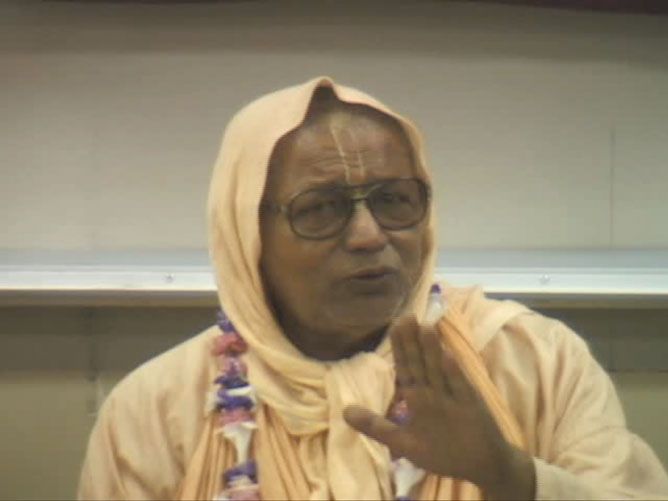WISDOM STORIES
BRAHMA, INDRA, AND VIROCHANA
How the ātma is realised through enquiry and service to Śrī Guru.
Adapted from a parable by Srila Bhakti Siddhanta Saraswati Thakur.

Once upon a time, Lord Brahmā, the first created being in the material universe, announced, “The ātma (the true self) is beyond good, bad, old age, hunger, thirst, suffering, and death. Anyone who seeks to realise the ātma according to the guidance of the Vedas and a Guru can perceive the ātma and become glorious in every respect. Innumerable universes and all the opulence within them run to serve anyone who has realised the ātma.”
Brahmā’s announcement was passed on through the generations, and eventually Lord Indra, the king of the godly people in the celestial plane of Svarga, and Virochana, the king of the ungodly people in subterranean region known as Sutala, both concluded, “What do we have to lose in trying to realise the ātma when such a great prospect awaits one who realises it?” Thinking in this way, they both came to Lord Brahmā to learn about the ātma.
Lord Brahmā told them that they needed to observe a period of disciplined training (brahmacharya) for thirty-two years before being taught about the ātma, and once they completed this, Brahmā said to them, “After giving up all material desires, the person whom the great yogīs see within their eyes is the ātma. This ātma is eternal and is the source of freedom from lamentation, fear, and death.”
Neither Indra nor Virochana could grasp the meaning of Brahmā’s teaching, and they asked, “O Master, when we look at our reflection in water or a mirror, what is it that we see in our reflection that is the ātma?”
Brahmā replied, “Look at your own ātma in this cup full of water and then ask me what you don’t understand about it.”
Both Indra and Virochana looked attentively into the cup of water but remained puzzled and did not ask anything. So, Brahmā said to them, “What do you see?”
They replied, “Master, we see our reflection, from our toenails to the hair on our heads.”
Brahmā said, “Cut off your toenails and hair, adorn yourselves in fine garments and ornaments, and again look at yourselves in the cup of water.”
They did so, and Brahmā asked them, “What do you see?”
They replied, “We see our reflections just as before but without toenails and hair and with fine cloth and ornaments.”
Brahmā thought, “They are unable now to realise the actual nature of the ātma, but later they may be able to understand once they become mature and purified by observance of dharma.”
So, Brahmā then told them, “He whom you see is the ātma.”
Virochana returned home and taught his countrymen, “This body is the ātma. This body should be our object of worship. It is only through service to the body that we attain good fortune in this world and the next.”
Indra started on his way back to Svarga, but he began to think about Brahmā’s words again and again: “There must be some deeper meaning within the teaching Brahmā has given. Brahmā couldn’t have meant that our reflection in the water, our body, is the ātma. I should go back and try to learn more.”
Indra then returned to Brahmā ready to be trained further. Seeing Indra, Brahmā said, “O Indra, you left happily with Virochana. Why have you come back?”
Indra replied, “O Master, when I looked at my reflection in the water, I saw that before I cut off my toenails and hair and put on fine cloth and ornaments, I appeared in that way, and after I cut off my toenails and hair and put on fine cloth and ornaments, I appeared in that way. So, I understand that my reflection will appear however my body is treated. So, if this body is destroyed, then its reflection will be as well. Therefore, I do not understand how I have gained anything by thinking that the reflection I see in water is the ātma. Rather, it seems impossible that this could ever be the ātma because this reflection is not eternal and unchanging.”
Brahmā replied, “Indra, what you have said is correct. I will teach you again about the ātma, but you should live and serve in the home of your Guru for thirty-two years before I instruct you.”
When Indra had done this, Brahmā taught Indra, “He who roams about in dreams is the immortal ātma.”
Indra happily departed after receiving this teaching, but before he reached home, he began to consider within his mind, “If someone can see in dreams but is blind while awake, then what is their real self? Is it what they see while awake or what they see while dreaming? Yet it doesn’t seem that either of these could be the immortal ātma. Therefore, what do I gain by thinking that the ātma is the person I appear as in dreams?”
Thinking in this way, Indra returned to Brahmā and conveyed his thoughts. Brahmā told Indra to reside with him for another thirty-two years and then listen to further instructions about the ātma. Brahmā eventually said, “The ātma who is manifest during the time of sound sleep is the immortal ātma.”
Satisfied with this statement, Indra departed, but as he thought it over, a doubt arose in his mind. He returned to Brahmā, and said, “If he who is self-illuminated during sound sleep is the ātma, then why does the sense of ‘I’ which remains continuously within us while awake and in dreams become blocked during sound sleep? As you have said, the ātma is ever-lasting.”
Brahmā told Indra to live with him for another five years. He then instructed Indra, “The body made of the five gross elements and the subtle body, the body you have in dreams, are coverings over the ātma. The ātma is actually the bearer and animator of both the gross and subtle bodies.
evam evaiṣa samprasādo ’smāch chharīrāt samutthāya paraṁ jyotir upasampadya svena rūpeṇābhiniṣpadyate. sa uttamaḥ puruṣaḥ. sa tatra paryeti jakṣan krīḍan ramamāṇaḥ.
(Chhāndogya-upaniṣad: 8.12.3)
“Upon attaining liberation, the ātma arises from the gross and subtle bodies and becomes established in their own supramundane spiritual form made of spiritual light. This ātma is the highest person, and in the spiritual domain the ātma enjoys, plays, and becomes immersed in bliss.”
Indra continued residing with his Guru, and after hearing this teaching and living in surrender, he was able to realise the nature of the ātma. He thus became fulfilled.
Purport
This story is based on an account in the Chhāndogya-upaniṣad. The main lessons to be gained from it is that learning from a realised Guru is essential.
tad viddhi praṇipātena paripraśnena sevayā
upadekṣyanti te jñānaṁ jñāninas tattva-darśinaḥ
(Śrīmad Bhagavad-gītā: 4.34)
To learn spiritual truth (to realise the ātma), we need to take shelter of a Guru and fulfil the responsibilities of a disciple. These are summarised by Lord Krishna as (1) surrender, (2) enquiry, and (3) service. Brahmā requested Indra and Virochana to reside with him so that they could engage in service, which purifies the mind of all prejudices, misconceptions, and attachments (through a process known as chitta-śuddhi). Once this process has advanced, one can clearly understand and realise spiritual truth.








